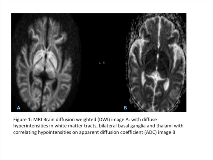Fulminant Vigabatrin Toxicity During Combination Therapy With High-Dose ACTH: A Case Series
Abstract number :
2.273
Submission category :
7. Antiepileptic Drugs / 7D. Drug Side Effects
Year :
2018
Submission ID :
502438
Source :
www.aesnet.org
Presentation date :
12/2/2018 4:04:48 PM
Published date :
Nov 5, 2018, 18:00 PM
Authors :
Sonam Bhalla, University of Louisville; Vinay Puri, University of Louisville; and Karen Skjei, University of Louisville
Rationale: Vigabatrin (VGB), ACTH and prednisone are first line treatments for infantile spasms (IS) with recently reported benefits from use of combination therapy. VGB associated brain abnormalities on magnetic resonance imaging (MRI )(VABAM) is a well-reported side effect of VGB treatment. It is generally asymptomatic and reversible. Here we report a series of patients with IS who developed severe adverse effects on combination of VGB and ACTH therapy. Methods: Detailed chart review and literature search. Results: Case 1 was a 7-month (mo) male (M) with Trisomy 21 who developed IS at 5 months of age. High dose ACTH (150 U/m2/day) and VGB (titrated to 160 mg/kg/day) were started simultaneously. Spasms and hypsarrhythmia resolved by 4 weeks, but spasms returned 3 days after ACTH was weaned off. Low dose ACTH was resumed with a slower wean. Two weeks later, he developed severe choreiform movements of extremities, orolingual dyskinesias, somnolence and vital sign irregularities requiring ICU admission. VGB and ACTH were weaned rapidly. ICU course was complicated by persistent dysautonomia, respiratory distress and intractable chorea. Brain MRI showed diffuse cortical atrophy with hyperintensities in white matter tracts, bilateral basal ganglia, thalami, brainstem and cerebellum (fig.1). Care was eventually withdrawn. Brain autopsy demonstrated diffuse spongiform vacuolar edema in white matter tracts, basal ganglia, thalamus and brainstem consistent with VGB toxicity. Case 2 is a 20 mo female (F) with left hemimegalencephaly, right perisylvian polymicrogyria, left facial hemihypertrophy and focal epilepsy who developed IS at 2.5 mo of life. VGB at 150 mg/kg/day was started. Due to persistent spasms, prednisone was added which was later switched to high dose ACTH. Three weeks later the patient presented with lethargy, poor suck, aspiration with oral feeds and flaccid paraplegia of bilateral lower extremities. MRI Brain showed symmetric diffusion restriction in bilateral basal ganglia, thalami and brainstem. MRI spine demonstrated extensive spinal epidural lipomatosis (SEL) extending from T6- S3 level with moderate to severe thecal sac compression, requiring surgical decompression. MRI brain lesions were attributed to VGB, which were reversible. Case 3 is a 8 mo M with trisomy 21 who presented with IS at age 6 mo. He was started on ACTH 150 U/m2/day. After 2 weeks, due to persistent spasms, VGB was added and ACTH wean was initiated. By the 3rd week of VGB (at 150 mg/k/day), spasms and hypsarrhythmia had resolved but he developed somnolence, decreased feeding, decreased movements in legs, hematochezia, hypertension, myoclonus, chorea and orolingual dyskinesias. Retinal pigmentary changes were also noted. MRI brain showed typical VABAM hyperintensities and diffuse cortical atrophy (fig 2). MRI spine showed diffuse SEL. VGB was weaned with improvement of encephalopathy after a few weeks. Case 4: is a 4 mo F who had presented with developmental regression from IS. She was started on combination therapy of high dose ACTH and VGB in anticipation of refractory spasms due to strong family history of intractable spasms. A week later, she developed involuntary choreiform movements of head with tongue thrusting only during wakefulness. There was no EEG correlation for epileptic activity with these movements. IS and hypsarrhythmia improved after 3 weeks. Chorea improved gradually over next 2 months after VGB dose was decreased. Conclusions: This case series raises concerns for safety of combination therapy in infants with symptomatic IS.VGB causes intramyelinic edema and white matter spongiosis, which can cause life threatening encephalopathy and extrapyramidal symptoms. There might be an increased risk of VABAM with concurrent use of high dose steroids. Funding: None

.tmb-.png?Culture=en&sfvrsn=af4d61be_0)